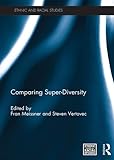Comparing Super-Diversity
Language: English Publication details: Oxford Routledge 20171002Edition: 1Description: 130 pISBN:- 9781317418276
The concept of ‘super-diversity’ has received considerable attention since it was introduced in Ethnic and Racial Studies in 2007, reflecting a broadening interest in finding new ways to talk about contemporary social complexity. This book brings together a collection of essays which empirically and theoretically examine super-diversity and the multi-dimensional shifts in migration patterns to which the notion refers. These shifts entail a worldwide diversification of migration channels, differentiations of legal statuses, diverging patterns of gender and age, and variance in migrants’ human capital. Across the contributions, super-diversity is subject to two modes of comparison: (a) side-by-side studies contrasting different places and emergent conditions of super-diversity; and (b) juxtaposed arguments that have differentially found use in utilizing or criticizing ‘super-diversity’ descriptively, methodologically or with reference to policy and public practice. The contributions discuss super-diversity and its implications in nine cities located in eight countries and four continents. This book was originally published as a special issue of Ethnic and Racial Studies.
There are no comments on this title.
